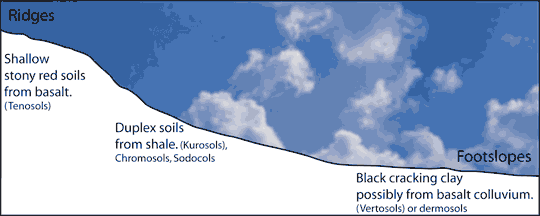Chromosols, Kurosols and Sodosols
Similarities: on Tocal we find that they:
- are problem soils
- have duplex profiles with sharp differeneces between horizons
- are found on rolling slopes and crests, and on old high terraces
- have parent material of weathered sedimentary rocks - sandstone/conglomerate
- support a native vegetation of spotted gum forest
- can show dramatic increase in productivity with high inputs. These inputs applied to the dairy soils have included chicken litter and other fertilisers, as well as irrigation to promote the growth of high quality kikuyu-based pasture.
Common features include:
- a loamy topsoil, bleached A2 horizon and medium clay subsoil which is impermeable
- weathering and leaching
- moderately to strongly acid (except for Sodosols)
- crusting, hardsetting and dispersion
- poor internal drainage - waterlogging at junction of topsoil and subsoil indicated by mottling
- difficult to till: rain won't infiltrate due to poor surface structure
- don't encourage plant growth, crops show poor establishment and growth
- light-textured topsoil with low wet bearing strength - don't work them when they are too wet or two dry.
Differences
- Sodosols are not acidic and are sodic (more than five percent sodium in the CEC ) and alkaline at depth. There are a few Sodosols at Tocal interspersed between the more extensive Chromosols in Lemon Tree and Canobies paddocks. Some Sodosol has been detected in Calving paddock (which is mostly Dermosol)
- Chromosols are not strongly acid down the profile and are not sodic. Chromosols are found throughout Tocal in Bush, Clements Farm, Shell, Run and Lemon Tree paddocks and Creek, Heifer paddocks and all the paddocks that contain Kurosols.

Rudosols and Tenosols
We have divided the Rudosols on Tocal into Erosional Rudosols and Alluvial Rudosols.
- Erosional Rudosols and Tenosols are gravelly soils found in the steeper country of View, Shell, Lemon Tree, Ridge, Run, Heifer, Bush, Top Bush and Quarry paddocks. See Site 13 View paddock.
- They feature:
- shallow and stony soils on steep slopes
- limited water holding capacity due to the shallow soil.
- The Alluvial Rudosols on Tocal are recent alluvial soils bordering the Paterson River. They are among the most productive soils on Tocal. These areas are prone to flooding and are essentially sand and silt deposits. They:
- are deep soils
- hold moisture well if they are medium textured
- are easy to work.
- These soils form the main cropping areas of Tocal, and would have been cleared of their dense, rainforest vegetation in the early years of European settlement. A wide variety of crops were experimented with , including wheat, maize, cotton and especially tobacco.
- The soils now support annual or short-term rotations of maize and lucerene for forage for the dairy.
- See site 1 from Windmill paddock for an example of a Tocal Rudosol (alluvial).
Hydrosols
Hydrosols occur at Site 3 Top Flat and Site 18 Racecourse.
The features of Hydrosols on Tocal are that they:
- form in low-lying situations subject to permanent or seasonal water logging
- have poor site and internal drainage indicated by rusty mottling in subsoil
- have a high organic matter content
- are heavy clay soils that are hard to cultivate.
Black Vertosols (brown clays / black earths)
On backplains and backswamps uniform fine-textured soils have developed from the slow settling of suspended clays. Examples are site 5 from Phillips paddock and site 19 from the Racecourse paddock Gilgai. These soils are Vertosols, also known as cracking clay soils.
Black Dermosols
Features of Black Dermosols on Tocal are:
- formed on lower slopes and plains from colluvium / alluvium (see site 2 Bottom Flat and site 9 Lucerne paddock) or Basaltic colluvium (see site 10 from Calving paddock and site 11 from Springer 1).
- moderately well to imperfectly drained
- gradational profiles with structured B2 horizon
- deep humic topsoil which is acid
- weakly weathered and weakly leached - pH increases with depth.
Red Ferrosols
The red Ferrosol derived from weathered basalt at Site 6 Bowkers Red is described as one of the best soils at Tocal. It supports a perennial native pasture that has never been fertilised. Its good physical properties - well structured surface soil allowing excellent moisture penetration, and good drainage throughout the profile - are due to iron oxides binding the clay particles into stable aggregates. Unfortunately this type of soil only occurs in a very small corner of the property.
Tocal newsletter
Want to find out about news, events, courses and publications?

